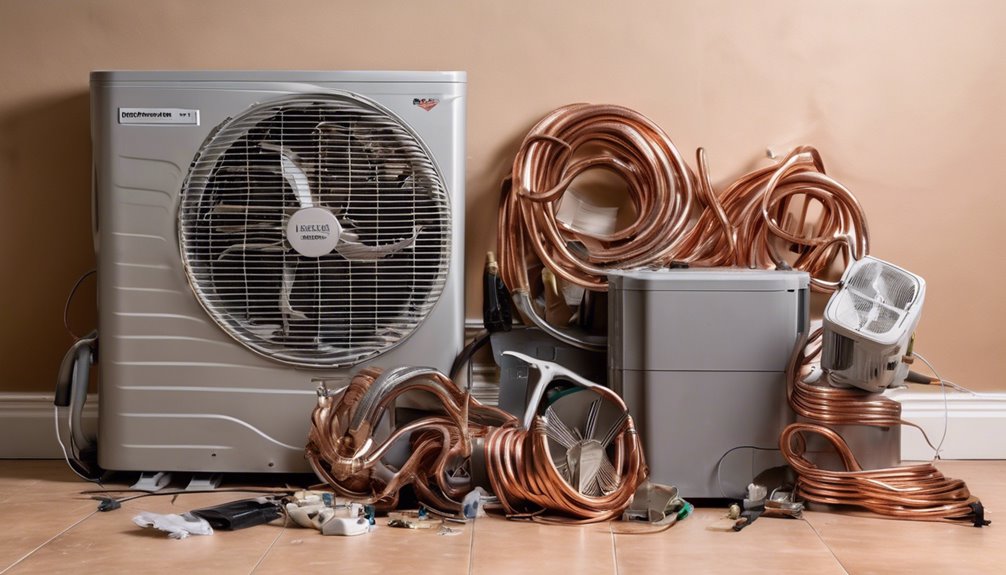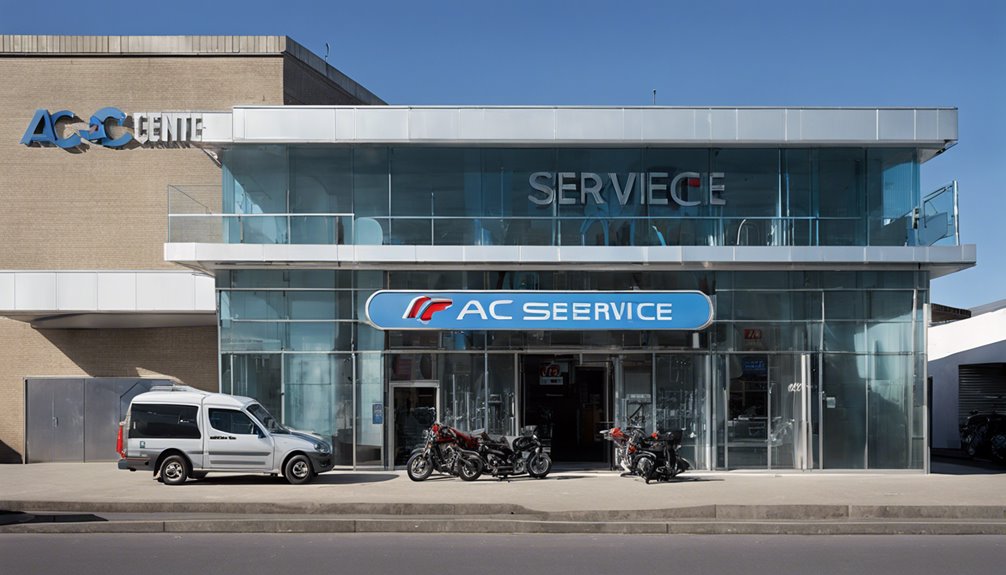To fix low cooling in your AC, start by checking and cleaning the air filter, and inspecting and clearing the condenser coils. Then, verify proper refrigerant levels and ensure proper airflow and ventilation. Additionally, look for blockages in the air ducts and check the thermostat settings and calibration. By addressing these common issues, you'll be well on your way to resolving the problem and enjoying a cooler, more comfortable space – and there may be a few more simple tweaks to explore that can make all the difference.
Key Takeaways
- Check and clean the air filter every 1-2 months to ensure better airflow and cooling performance.
- Inspect and clear the condenser coils regularly to prevent dirt and debris buildup that reduces cooling performance.
- Verify proper refrigerant levels and fix any leaks to prevent low cooling and further damage.
- Ensure proper airflow and ventilation by optimizing air intake and unblocking indoor vents.
- Check thermostat settings and calibration to ensure the AC is working efficiently and accurately.
Check and Clean the Air Filter
A dirty air filter can be a major culprit behind low cooling in your AC.
When was the last time you checked and cleaned it? Dirty filters can reduce airflow, causing your AC to work harder and cool less efficiently.
You'll be surprised at how much of a difference regular filter maintenance can make. Try to check your filter every 1-2 months, depending on usage and air quality.
If it's dirty, replace it with a new one or clean it according to the manufacturer's instructions. A clean filter will allow your AC to breathe easily, resulting in better airflow and cooling performance.
Inspect and Clear the Condenser Coils
Your condenser coils, usually located outside, play a crucial role in dissipating heat from your AC.
They're responsible for releasing heat from the refrigerant, so it's essential to keep them clean and free of debris. Dirty coils can significantly reduce your AC's cooling performance, leading to low airflow and increased energy bills.
Clean condenser coils are crucial, as dirty ones can reduce cooling performance, leading to low airflow and increased energy bills.
Inspect your condenser coils regularly to ensure they're not clogged with dirt, leaves, or other obstructions. Use a garden hose to gently wash away any debris, following coil cleaning tips to avoid damaging the coils.
Regular condenser maintenance can help prevent overheating and improve your AC's overall efficiency. By keeping your coils clean, you can enjoy better cooling performance and lower energy costs.
Verify Proper Refrigerant Levels
You'll want to ensure the refrigerant levels are correct, as low levels can significantly reduce your AC's cooling performance.
To do this, you'll need to check for refrigerant leaks and inspect the refrigerant charge to identify any issues. By verifying the refrigerant levels, you can rule out a common cause of low cooling and potentially fix the problem.
Check Refrigerant Leaks
Refrigerant leaks can be a silent killer of your air conditioner's cooling performance, slowly draining its ability to keep your home comfortable.
If you suspect a leak, it's essential to identify and fix it quickly. You'll need professional-grade refrigerant detection tools to pinpoint the source of the leak.
Look for signs like ice buildup, hissing sounds, or oily residue near fittings and connections. Use a leak diagnosis kit to confirm the leak and identify its location.
Remember to always follow safety guidelines when handling refrigerant and detecting leaks. A timely fix will prevent further damage and restore your AC's cooling performance.
Inspect Refrigerant Charge
Having addressed potential refrigerant leaks, it's now time to ensure the AC's refrigerant charge is at optimal levels.
You'll need to inspect the refrigerant charge to verify proper levels. There are different refrigerant types, such as R-22, R-410A, and R-134a, so make sure you know which one your AC uses.
Perform a system analysis to determine the recommended charge amount. You can find this information in the AC's manual or on the manufacturer's website.
Use a refrigerant gauge to measure the current charge level. Compare it to the recommended level and adjust as needed. Remember to always follow safety guidelines when handling refrigerants.
Proper refrigerant levels will help restore your AC's cooling performance.
Ensure Proper Airflow and Ventilation
How often have you felt a warm breeze blowing from your AC vents, leaving you wondering what's going on?
It's likely due to poor airflow and ventilation. To ensure proper airflow, you need to optimize your air intake.
Poor airflow and ventilation are likely culprits, optimized air intake is the solution.
Check that your outdoor unit has at least three feet of clearance from any obstructions, and make sure your indoor vents aren't blocked by furniture or curtains.
A well-designed ventilation system is also crucial. Ensure that your AC's ventilation system is properly installed and functioning as intended.
This includes ensuring that air can circulate freely throughout your home. By optimizing air intake and ventilation system design, you'll be able to enjoy a cooler, more comfortable living space.
Look for Blockages in the Air Ducts
Now that you've ensured proper airflow and ventilation, it's time to turn your attention to the air ducts.
You'll want to check for debris buildup that might be restricting airflow, inspect the ducts for leaks and gaps that can let cooled air escape, and verify that the ducts are the proper size for your AC unit.
Check for Debris Buildup
Debris buildup in your air ducts is a common culprit behind low cooling in your AC.
When debris like dust, dirt, and pet hair accumulates, it obstructs airflow, reducing your AC's cooling capacity. You'll need to perform debris removal to get your AC running smoothly again.
Start by turning off the power to your AC unit. Then, remove the vent covers and use a vacuum or brush to clear out any visible debris. Don't forget to check the ducts themselves, as blockages can occur anywhere.
Inspect for Leaks and Gaps
Your air ducts are vulnerable to leaks and gaps, which can significantly reduce your AC's cooling performance.
These openings allow cooled air to escape, making your AC work harder and increasing your energy bills.
To inspect for leaks and gaps, turn off your AC and use a candle or incense stick to detect air movement near joints, vents, and connections.
If you notice air movement, mark the area for repair.
Apply a sealant to these gaps to prevent air leaks.
Also, check windows and doors for gaps, and apply window caulking to seal them.
Verify Proper Duct Size
Three key factors affect airflow in your air ducts: proper duct size, blockages, and kinks.
If your ducts are too small, they'll restrict airflow, reducing your AC's cooling capacity. You'll need to ensure your ducts are the right size for your AC unit and building layout.
Consider duct material options, such as flexible or rigid ducts, and duct design considerations, like the number of bends and turns. A well-designed duct system will minimize airflow resistance, allowing your AC to cool your space more efficiently.
Check your ducts for blockages, like furniture or curtains, and kinks that can restrict airflow. By verifying proper duct size and addressing blockages, you'll be one step closer to resolving low cooling issues in your AC.
Check the Thermostat Settings and Calibration
The thermostat is the brain of your air conditioning system, controlling when the AC kicks in and how cool the air gets.
You'll want to ensure it's working correctly to fix low cooling issues.
Check your thermostat settings and calibration by following these steps:
- Verify thermostat accuracy: Ensure the thermostat is reading the correct temperature. You can use a separate thermometer to compare readings.
- Check for calibration issues: If your thermostat is programmable, check that it's properly calibrated. You may need to refer to the user manual for specific instructions.
- Adjust the thermostat sensitivity: If the thermostat is too sensitive, it may cause the AC to kick in and out too frequently, resulting in inefficient cooling. Adjust the sensitivity to optimize performance.
Frequently Asked Questions
Can I Fix Low Cooling in AC Without Professional Help?
You can try DIY troubleshooting before calling a pro; many AC issues can be resolved through simple self-repair options, but if you're not comfortable with DIY fixes, it's best to seek professional help to avoid further damage.
How Often Should I Clean the AC Filter for Optimal Performance?
You should clean your AC filter every 1-3 months for optimal performance, as dirty filters reduce airflow and worsen air quality. Regular filter maintenance ensures better air circulation, improving your home's overall air quality and keeping your AC running efficiently.
Will a Dirty AC Filter Increase My Electricity Bill?
You're wondering if a dirty AC filter will hike your electricity bill? Yes, it will! A dirty filter reduces filter efficiency, making your AC work harder, thus increasing energy consumption and your electricity costs.
Can I Use a Regular Vacuum to Clean the Condenser Coils?
You're wondering if a regular vacuum can clean the condenser coils, but it's not the best tool for coil maintenance. Vacuum limitations mean it may not reach tight spaces or remove stubborn debris, so consider a specialized coil cleaning brush for the job.
Will Adjusting the Thermostat Setting Affect My Ac's Cooling Performance?
When you adjust the thermostat setting, you're likely hoping to escape those sweltering summer temperatures, but don't expect it to drastically impact your AC's cooling performance, as temperature fluctuations are more dependent on other factors, like airflow and coil cleanliness.
Conclusion
You've taken the steps to troubleshoot and fix the low cooling in your AC. By checking and cleaning the air filter, inspecting and clearing the condenser coils, verifying proper refrigerant levels, ensuring proper airflow and ventilation, looking for blockages in the air ducts, and checking the thermostat settings and calibration, you've tackled the most common causes of low cooling. Now, sit back and enjoy the cool comfort of your home!



